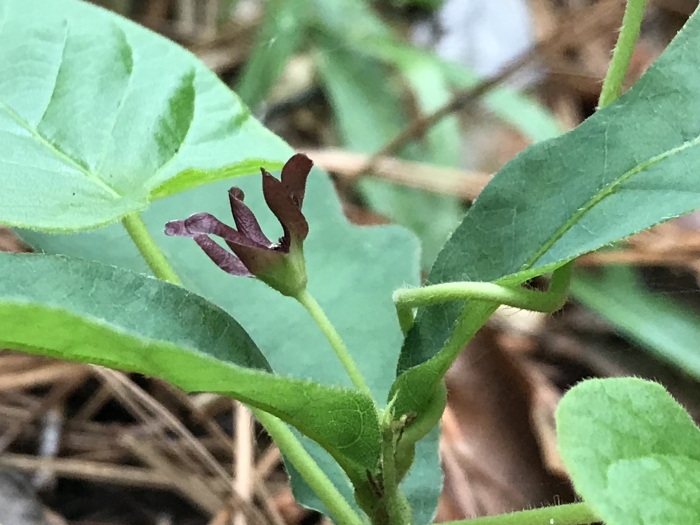Oldfield Milkvine
(Matelea decipiens)
Oldfield Milkvine (Matelea decipiens)
/
/

Laura Clark
CC BY 4.0
Image By:
Laura Clark
Recorded By:
Copyright:
CC BY 4.0
Copyright Notice:
Photo by: Laura Clark | License Type: CC BY 4.0 | License URL: http://creativecommons.org/licenses/by/4.0/ | Rights Holder: Laura Clark | Publisher: iNaturalist | Date Created: 2019-05-11T14:45:26Z |

























Estimated Native Range
Summary
Matelea decipiens, commonly known as Oldfield Milkvine, is a perennial vine that is native to a variety of habitats in the south and central and eastern United States, including open deciduous woods, forest edges, and stream banks. It is particularly adapted to disturbed areas such as old fields, hence its common name. This vine can climb up to 6-10 feet (1.8-3 meters) when supported. Oldfield Milkvine has heart-shaped leaves that are typically 2-4 inches in size and produces clusters of deep purple, star-shaped flowers in the late spring to early summer. The flowers are modest in size but are quite showy due to their intricate structure and coloration.
Oldfield Milkvine is valued for its ability to attract pollinators, including butterflies and bees, making it a beneficial addition to wildlife gardens and naturalized areas. It is relatively low-maintenance and can thrive in a range of soil types, though it prefers moist, well-drained soils. It tolerates partial shade to full sun exposure. While not commonly used in formal garden settings, it can be an interesting feature on trellises or fences in informal or naturalistic landscapes. The milky sap found in the stems and leaves is characteristic of the Apocynaceae family and can be a skin irritant, so care should be taken when handling the plant. The fruit is a large, spindle-shaped follicle that splits open to release seeds with silky tufts for wind dispersal.CC BY-SA 4.0
Oldfield Milkvine is valued for its ability to attract pollinators, including butterflies and bees, making it a beneficial addition to wildlife gardens and naturalized areas. It is relatively low-maintenance and can thrive in a range of soil types, though it prefers moist, well-drained soils. It tolerates partial shade to full sun exposure. While not commonly used in formal garden settings, it can be an interesting feature on trellises or fences in informal or naturalistic landscapes. The milky sap found in the stems and leaves is characteristic of the Apocynaceae family and can be a skin irritant, so care should be taken when handling the plant. The fruit is a large, spindle-shaped follicle that splits open to release seeds with silky tufts for wind dispersal.CC BY-SA 4.0
Plant Description
- Plant Type: Herb, Vine
- Height: 1-3 feet
- Width: 1-3 feet
- Growth Rate: Moderate
- Flower Color: Red
- Flowering Season: Spring, Summer
- Leaf Retention: Deciduous
Growth Requirements
- Sun: Part Shade, Full Sun
- Water: Medium
- Drainage: Medium, Fast
Common Uses
Butterfly Garden, Low Maintenance
Natural Habitat
native to a variety of habitats in the south and central and eastern United States, including open deciduous woods, forest edges, and stream banks
Other Names
Common Names: Angularfruit Milkvine, Oldfield Milkweed
Scientific Names: , Matelea decipiens, Gonolobus decipiens, Odontostephana decipiens,
GBIF Accepted Name: